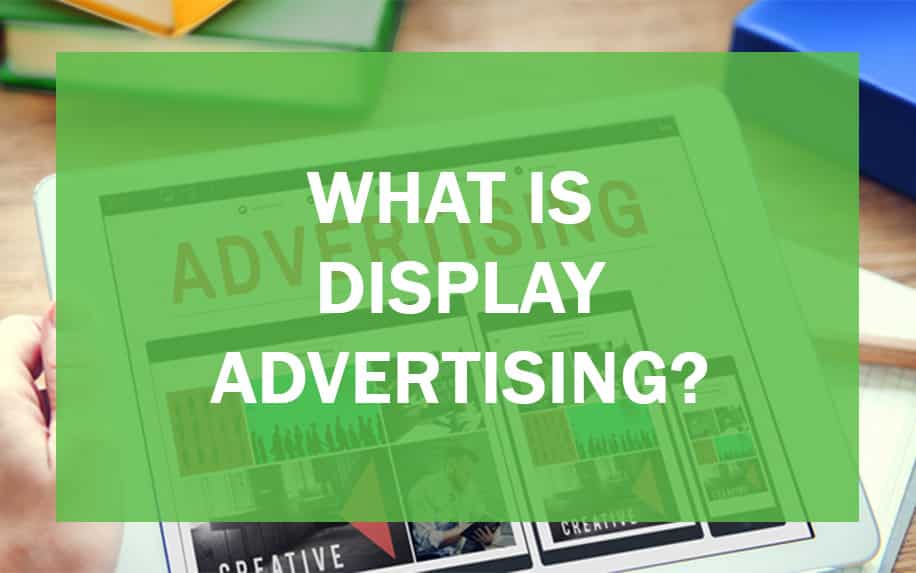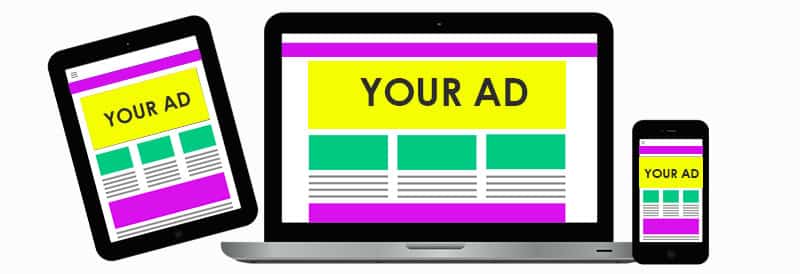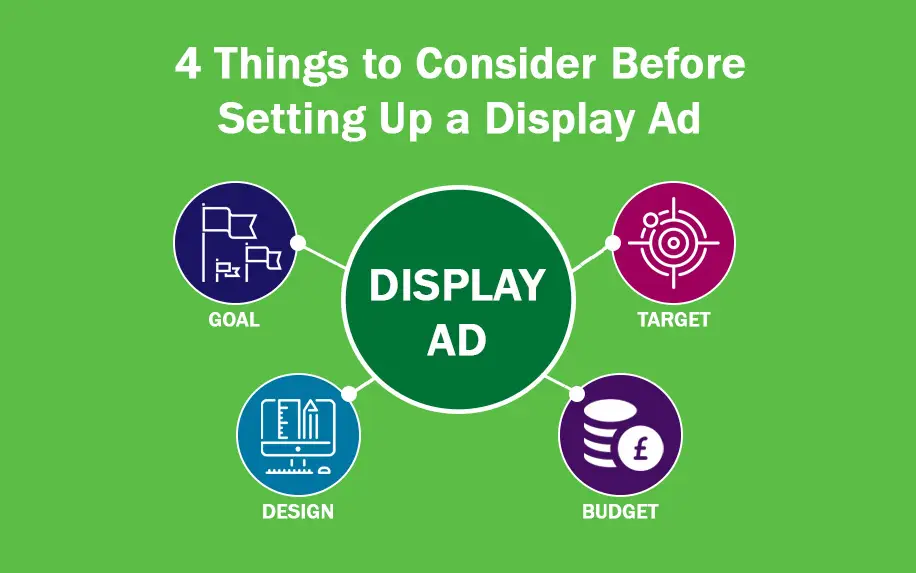What is Display advertising? It is online advertising designed to show your company’s ad on a relevant third-party website if you have ever been on a website and noticed ads on the sidebar or top banner, that’s display advertising.
By venturing into display advertising this allows your ad to fit seamlessly into an audience’s daily life. Whether they are browsing online, watching YouTube or even checking their email.
People use display ads for the same reasons traditional ads are employed – to grab attention and raise awareness. However, display ads have an added advantage. They allow you to target specific demographics to find the people who’d be most interested in your business, rather than leaving it to chance like most traditional advertising methods.
Display advertising is tailored, effective, cheaper and relevant to your intended market. For digital advertisers far and wide – this ticks a lot of important boxes. There’s no wonder why worldwide display advertising is expected to grow by 18.5% in 2021, according to Bannerflow.
Throughout this blog, we’ll delve deep into the world of display advertising, including the good, the bad and everything in between.

Table of Contents
What Is Display Advertising?
In the dynamic realm of digital marketing, display advertising remains a cornerstone of effective brand communication and engagement. As brands navigate the ever-evolving landscape of online advertising, display advertising continues to demonstrate its resilience and effectiveness, offering a powerful medium for capturing attention, conveying brand messages, and driving meaningful connections with consumers.
The latest data underscores the enduring relevance of display advertising. According to eMarketer, display advertising spending is projected to reach $77.72 billion in 2023, accounting for a significant share of total digital advertising expenditure. A resurgence in programmatic advertising fuels this growth, the use of data-driven automation to optimize ad placements and enhance targeting capabilities.
Display advertising’s performance is also showing positive signs. A recent study by Statista revealed that the average click-through rate for display ads increased from 0.44% in 2021 to 0.48% in 2022, indicating a growing receptivity among consumers towards display advertising. This trend is attributed to advancements in ad creativity, targeting precision, and the ability to deliver relevant messages across multiple devices.
For competitive brands in 2023, mastering display advertising is not just an option; it’s an imperative. In a crowded online marketplace, display advertising provides a unique opportunity to cut through the noise, capture consumer attention, and establish a strong brand presence. Through the strategic use of display ads, brands can effectively communicate their value proposition, engage with potential customers, and drive desired actions, such as website visits, conversions, and brand awareness.
To harness the full potential of display advertising, brands must embrace a data-driven approach, leveraging audience insights, targeting strategies, and creative optimization techniques. By understanding their target audience’s preferences, behaviors, and online habits, brands can tailor their display ad campaigns for maximum impact. Additionally, utilizing advanced targeting options, such as demographic targeting, interest-based targeting, and behavioral targeting, ensures that display ads reach the right audience at the right time.
Beyond targeting, creativity plays a pivotal role in the success of display advertising. Engaging and visually appealing ad formats, such as native ads, video ads, and interactive ads, capture attention and resonate with consumers. By embracing innovation and storytelling techniques, brands can create memorable ad experiences that leave a lasting impression and drive desired outcomes.
As we move forward in the digital marketing landscape, display advertising remains a vital tool for brands seeking to connect with consumers, build brand awareness, and drive business growth. By understanding the latest trends, embracing data-driven strategies, and prioritizing creativity, brands can effectively leverage display advertising to achieve their marketing goals and stay ahead of the competition.
The Good and Bad of Display Advertising
Like everything in life, weighing up the pros and cons of something before diving straight in is important. That’s why we’ve created this blog – so you can see for yourself whether display advertising is the right move for you.
First of all, we’ll start on a positive note with the good parts of display advertising.

Display Advertising: The Good
Display ads are relatively inexpensive when compared to other online advertising efforts. You just need one potential customer to convert into a paying customer in order to get a return on investment. Here are a few more reasons why display advertising is beneficial:
They’re Visually Appealing
People tend to respond much more to innovative, visually-led ads. If you think of an ad you saw recently – think about why you remember it. It is probably because of its visual elements, whether it be an image or a video.
With high quality graphic content, these instantly trump lengthy character counts on text-heavy ads. Luckily with these ads, you can use images, video or audio in order to grab the attention of users.
Increase Brand Awareness
Display ads are a great way to build brand awareness. As these ads are visual, they can be styled using your logo, company colours, slogans and other attributes that people can instantly associate with your brand.
Display ads are extremely handy for boosting brand familiarity and initiating product attraction. The more people are exposed to your ad, the more they will become aware of you and trust you. This all contributes to engaging viewers and encouraging them to click.
Allow Accurate Targeting
Display ads will allow you to target relevant people to your website. Using geographical and behavioural data, you can reach users that will benefit the most from your product or service.
You can also retarget, meaning you can reach out to people that have previously expressed interest in your business. This clever technology plays on a person’s existing curiosity, and helps lure ad viewers to take the plunge due to the familiarity, accessibility and convenience.
This acts as a win-win-win for everyone involved. The third party for securing funding – the advertiser for reaching a tailored audience – and the consumer for being conveniently presented with information that is relevant to them.
Provide Measurable Data
Display ads provide data that can help enhance your ads for future use. By gaining useful insights into your respondents reactions, you can monitor the success of your ad. From this data, you can see how many times people viewed or clicked your ad. You can even see if your visitor converted into a customer by making a purchase.
By learning more about your ad’s performance, this helps you understand where you need to improve, if you need to adjust your budget or consider new audiences. This means your business can constantly evolve and better your practice.
Display Advertising: The Bad
With everything, there are good and bad sides. While there are plenty of benefits that come with display advertising, it is useful to be aware of the disadvantages so you can make an informed decision.
Lower Click-Through Rate
Click-through rates (CTR) relate to how many times people actually click on your ad. Typically, display ads are there to act as a visual, meaning while people may enjoy looking at them – they are less inclined to click.
One way around this is by including a noticeable call to action (CTA). This means if someone is actively looking and is interested in your ad, if you provide them with a clear CTA, this will help hugely with the conversion journey.
Lower Conversion Rate
A low click-through rate can also have a knock-on effect with lower conversion rates. This relates to when a person purchases something at the end of their journey with your ad. Often, with it being difficult enough to get a person to click – getting them to buy is added pressure on top.
This also relates to people’s intentions. If a person is scrolling through a news website, they are not necessarily thinking about purchasing. Therefore they may not be ready to buy. Display ads are more suitable for long sales processes than for selling high volumes.
Ad Avoidance and Blockers
While your impressions may be high, this metric does not guarantee that viewers actually paid attention to your ad. As people nowadays are programmed to automatically reject ads as we are exposed to so many so often – this ad avoidance culture is a major downside.
Ad blockers are also a display ad’s worst enemy. With people wanting a break from ads when they are working online or simply enjoying some downtime, plenty of people have ad blockers downloaded. This stops potential viewers seeing your ad and therefore halts the ad’s effectiveness.
As we can see here after reviewing the pros and cons, there are certainly a lot more advantages associated with display advertising.
If you are curious about how to get started with display advertising, take a look at what you should consider first of all.
4 Things to Consider Before Setting Up a Display Ad

Before you embark on setting up your display ad, there are a number of things you should think about first. Without considering these vital aspects, you could risk making an ad that flops, as well as lose valuable budget money.
To ensure best practice is maintained, consider these top 4 things:
#1: Think About Your Goal
As a business owner or manager, you will know the importance of setting a goal before going forward with any important decisions. The same goes with display advertising. Without a clear intention, your ad will not succeed. By giving yourself something to aim towards – this will help you in the long-run.
Consider your digital marketing strategy – are you wanting to increase your online sales? Or boost brand awareness? This could be a huge determining factor before you proceed with display advertising.
#2: Who Do You Want to Target?
Before you start, it is essential that you consider who your target audience is, otherwise you will not know what websites to feature on and you will already be at a loss.
One way to consider your target market is by thinking of who your main customer is. Will they relate to the message you want to put out there? You can refine your audience even further by considering keywords, demographics, locations and interests. This will all help you categorise who will be seeing your ad and potentially taking action if they like what they see.
#3: Consider the Design
The design of a display ad is make or break. Too busy and it’ll put people off – too simple and it won’t stand out. This can apply to every element involved – the imagery or video, the copy, the colours – everything.
What’s important is making sure your design resonates with your brand. You want to catch people’s eye, but you also want them to recognise you. This is probably one of the tougher considerations to think about. But when you spend enough time trying to get it right, you will benefit in the long-run.
#4: Set Your Budget
This is where your strategy comes in again. WIth display advertising, you decide on a budget and pay for results – like when people actually click on your ad to visit your website.
Luckily, display advertising is quite flexible to suit a variety of budgets. However, you will want to make sure you get a return on investment for your design and copywriting efforts to make the ad in the first place. This is why each of these points go hand-in-hand to make display advertising work.
Table of average metrics and benchmarks for key display ad formats and placements:
| Format/Placement | Average CTR | Average Conversion Rate |
|---|---|---|
| Banner Ads | 0.48% | 0.72% |
| Rich Media Ads | 0.65% | 1.25% |
| Native Ads | 0.90% | 1.75% |
| Video Ads | 1.80% | 2.50% |
| Social Media Ads | 1.20% | 2.00% |
| In-App Ads | 1.50% | 2.25% |
| Desktop Ads | 0.55% | 0.85% |
| Mobile Ads | 0.85% | 1.35% |
| Top of Page Ads | 0.70% | 1.00% |
| Middle of Page Ads | 0.60% | 0.90% |
| Bottom of Page Ads | 0.50% | 0.80% |
Optimizing Landing Pages for Display Traffic
Landing pages serve as the final destination for display ad clicks, and their effectiveness plays a crucial role in determining the overall success of your display advertising campaigns. Since display traffic tends to be more brand-aware and receptive to messaging compared to search traffic, landing pages for display campaigns should be tailored to align with this audience’s expectations and preferences.
Key Considerations for Display Landing Pages:
- Relevance and Alignment: Ensure your landing page seamlessly aligns with the messaging and branding of your display ad. The landing page should reinforce the key message conveyed in the ad, maintaining a consistent brand experience and avoiding any disconnect that could lead to confusion or disappointment.
- Focus on Visual Appeal: Display ads are inherently visual, so leverage that strength in your landing page design. Use high-quality images, captivating visuals, and a visually appealing layout to maintain the engagement gained from the display ad.
- Compelling Headlines: Display ad audiences are likely to scan quickly, so make your headlines concise, attention-grabbing, and relevant to the ad’s message. Use strong verbs and highlight key benefits to pique their interest and encourage them to continue reading.
- Clear and Concise Copy: Keep your landing page copy concise, focused on the core message, and easy to read. Use a clear and consistent tone that aligns with your brand voice. Avoid lengthy paragraphs and focus on conveying the most important information in a digestible manner.
- Strong Calls to Action: Display ad audiences are often ready to take action, so provide clear and compelling calls to action (CTAs) that encourage the desired behavior. Use actionable verbs, highlight the benefits of taking action, and make the CTA buttons prominent and easy to find.
- Mobile Optimization: A significant portion of display ad traffic comes from mobile devices, so ensure your landing page is optimized for mobile viewing. Use responsive design, ensure elements are tap-friendly, and optimize loading times for a seamless mobile experience.
A/B Testing for Landing Page Optimization:
A/B testing is an invaluable tool for optimizing landing page performance and identifying the elements that resonate most effectively with your display ad audience. By testing different variations of landing page elements, you can gather data-driven insights to continuously improve the user experience and conversion rates.
Examples of A/B Tests for Display Landing Pages:
- Headline Variations: Test different headlines to determine which one captures attention most effectively and drives the highest click-through rates.
- CTA Text and Placement: Experiment with different CTA text, button colors, and placements to optimize the visibility and effectiveness of your calls to action.
- Landing Page Layout: Test different layout variations, such as the position of key elements, the use of white space, and the overall design structure, to find the layout that optimizes user engagement and conversions.
- Imagery and Visuals: Experiment with different images, color schemes, and visual elements to determine which ones resonate best with your display ad audience and enhance the overall appeal of the landing page.
- Form Design and Length: Test different form designs, such as the number and type of fields, the placement of the form, and the use of progressive profiling, to optimize form completion rates and minimize friction.
By continuously testing and refining your landing pages based on data-driven insights, you can create a landing page experience that is tailored specifically for your display ad audience, leading to improved conversion rates and a more successful display advertising strategy.
FAQ
Q: What are some of the latest trends in display advertising?
A: Some of the latest trends in display advertising include:
- The rise of programmatic advertising, which uses data and automation to optimize ad placements.
- The increasing use of native ads, which blend in with the surrounding content.
- The growing popularity of video ads, which are more engaging and effective than text ads.
- The use of mobile-first ad formats, as more and more people access the internet from their smartphones.
Q: What are some tips for creating effective display ads?
A: Here are some tips for creating effective display ads:
- Use strong visuals that capture attention.
- Keep your ad copy concise and to the point.
- Use a clear call to action that tells people what you want them to do.
- Target your ads to the right audience.
- Track your results and make adjustments as needed.
Q: How can I measure the success of my display advertising campaigns?
A: There are a number of ways to measure the success of your display advertising campaigns, including:
- Click-through rate (CTR): The percentage of people who click on your ad.
- Conversion rate: The percentage of people who take the desired action after clicking on your ad, such as making a purchase or signing up for a newsletter.
- Impressions: The number of times your ad is displayed.
- Cost per click (CPC): The amount you pay each time someone clicks on your ad.
- Return on investment (ROI): The amount of money you make from your display advertising campaigns compared to the amount you spend on them.
Conclusion
Display advertising remains a powerful tool for businesses of all sizes to reach their target audience and achieve their marketing goals. By understanding the latest trends, creating effective ads, and tracking your results, you can use display advertising to grow your business and achieve your desired outcomes.
For information on how to action these steps plus more, check out our Ultimate Guide to Display Advertising.
If you would like more advice on display advertising, simply message us. At ProfileTree, we are here to help businesses grow online. With our infinite knowledge of the digital world, we can help you make a start. We look forward to working with you!


